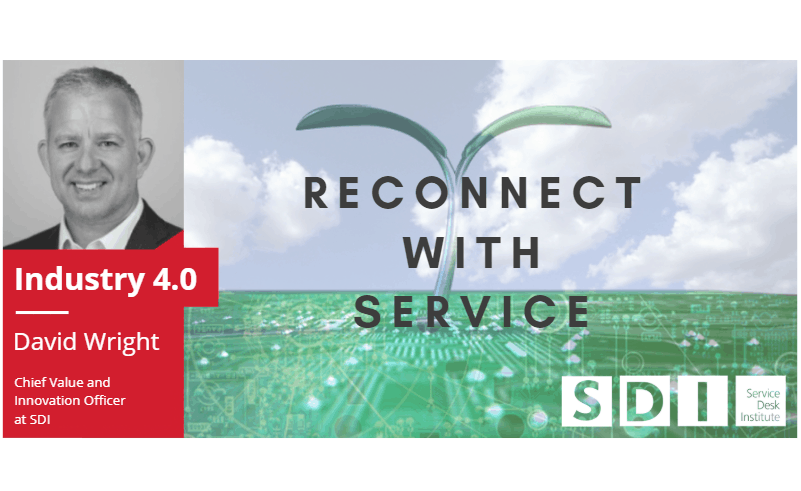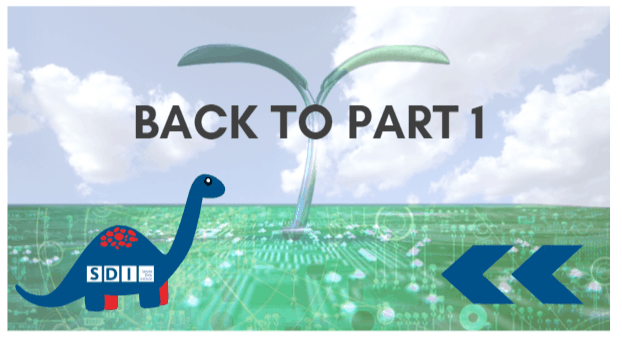
By David Wright, Chief Value and Innovation Officer, Service Desk Institute
Reconnect with Service: Part 2 of 2
IT Service Management Evolution
I’d like to think that over the next few years of IT service management evolution, we’ll start to move away from the place where we see the organisation as a bunch of technology and processes, and we start seeing it as a living system where we all participate. Just as we’ve seen over the last 3.8 billion years of life on this planet, that independent species started to work together and began to leverage those relationships in order to create the conditions for life; in the same way, an organisation can leverage relationships and collaborate in order to create conditions for service. IT is more than ever about relationships and mindfulness, rather than top down control and inflexible governance models, that’s so last century, right? So instead of seeing the business as something we provide technology or IT service management ‘to’, IT professionals are beginning to realise that the business is a community that we are here to join and enhance.
Hold on! What about adopting and adapting I hear you cry! The earth is a great example of how a system can adapt and deal with change to support the right outcomes. You know what, over 4 billion years ago, the sun was 25% cooler than it is today. Over time, earth trapped the heat from the sun, the planet warmed and the sun got hotter and hotter. Over that time earth systematically regulated itself, evolved and adapted for the good of what it supports; life. Earth is the greatest adapter to system change in the universe. Can we say the same about IT service management, and how it has systematically regulated itself, evolved and adapted over the last 30 years for the good of what it supports; it’s business community? I’m not so sure the earth would have so eloquently and successfully adapted for the good of life if it had been constrained by a governance model and a ‘no, I can’t because’ approach.
I’m not sure either, that we would have benefited from the earth viewing organisms as ‘users’. The term user has always sat uncomfortably with me, the term significantly contributes to the way some organisations unconsciously dehumanise the relationship between the service it provides and the consumer. The use of such terminology reinforces the disconnect between IT, ‘the business’ and service, which makes it easier to forget that service is actually about people. In IT service management, do we really still see the business community we service as nothing more than a bunch of users? Ask yourself, in IT service management, do we view the ‘user’ as a subsidiary item in the quest to meet an SLA or contractual obligation, or as the reason for our very existence?
Business organisations or organisms?
We’ve also seen in other industries that innovation and new ways to approach old problems can be inspired by nature. ‘Biomimicry’, for example, is the conscious emulation of nature’s genius, a way of making an intentional choice to look at other organisms for inspiration on how we can live better on this planet. Just as our species is exploring how can we create and innovate without destroying nature. In IT, we should be exploring how we can we create solutions and innovate without destroying service. Just as an organism creates conditions conducive to life. IT and IT service management, should be creating the conditions conducive to service in an organisation. There are ways to address old and new problems by looking beyond a prescriptive text book and re-imagining what service should be and can be. The service desk is a vital organ in the business organism, yep, there’s even a clue in the name ‘service’ desk. Real service exudes care for people, in the same way that people; care for people. Care is not a process, its altruistic and biological; its organic. By creating and providing brilliant service, we’re learning about our communality as an organisation and supporting its evolution.
Based on observations while working with teams that are connected to service in great organisations, we’ve recognised that they tend to exhibit similar characteristics, and to some degree, areas of communality. What types of characteristics I hear you ask? They include:
- Service connected organisations orientation, or basic attitude, beliefs and behaviors, which are related to people, teams, their customers and service.
- Service connected organisations are principally altruistic, they care unselfishly for the welfare of their staff and their customers.
- Service connected organisations recruit really well and are either becoming, or are, preferred employers, bringing in the right type, fit and caliber of staff to create and maintain a brilliant service culture.
- There is a lot of definition in service connected organisations, which creates context and clarity. An awareness and an understanding of what, how and why. An explanation of how to be part of an organisation and what’s expected from employees as part of that organisation.
- Service connected organisations empower their staff, they promote autonomy but with clear accountability, which helps to create ownership.
- Service connected organisations communicate openly and transparently, which all helps to create advocacy, for both staff and customer, building belief to encourage confidence, trust and a feeling of protection. Which in turn helps to shape the experience of being part of that environment, experience that encourages recognition, respect, innovation and change. An open, free thinking experience for the employee, that radiates, and is absolutely felt by the customer.
- Service connected organisations create an emotional connection between what they do, why they do it and the way they do it, that helps to create community, belonging, intimacy, love, and self-actualization.
- Service connected organisations have these building blocks defined, understood and critically practiced, and use all that to encourage, recognise and reward the resulting behaviours; the behaviours that help deliver their business strategy, business goals and business outcomes.
- Some of the best service desks we see, are very human and have managed to create willing advocates, eager to provide solutions and work together towards common goals across an organisation. That’s not just from an employee perspective but also from the perspective of a customer, and supports the creation of inspirational customer experiences, as some of the very best service desks we see actually do.
Reconnecting with service is an absolute must have strategy for any organisation that wants to continue to evolve and stay alive. Just in the same way as reconnecting humanity as a species with nature, is an absolute must have strategy for ours and our ecosystems future success. For those organisations who have lost the point of the absolute need of service, or are unable to grasp the organic relationship between IT service management and the business organism we support, there may be only one way from here on in, extinction. So be the change you wish to see in your organisation, challenge yourself and your organisation to re-connect with service. Oh, and by the way, did you know we share 25% of our genes with trees? Just saying…
David Wright, Chief Value and Innovation Officer, Service Desk Institute.
























